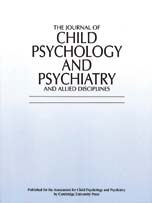Crossref Citations
This article has been cited by the following publications. This list is generated based on data provided by
Crossref.
Bowers, Tony
2001.
Cracking the Code for EBD.
Emotional and Behavioural Difficulties,
Vol. 6,
Issue. 1,
p.
19.
Muris, Peter
Meesters, Cor
and
van Melick, Marion
2002.
Treatment of childhood anxiety disorders: a preliminary comparison between cognitive-behavioral group therapy and a psychological placebo intervention.
Journal of Behavior Therapy and Experimental Psychiatry,
Vol. 33,
Issue. 3-4,
p.
143.
Muris, Peter
Meesters, Cor
and
Gobel, Marianne
2002.
Cognitive Coping vs Emotional Disclosure in the Treatment of Anxious Children: A Pilot-Study.
Cognitive Behaviour Therapy,
Vol. 31,
Issue. 2,
p.
59.
MURIS, PETER
SCHMIDT, HENK
ENGELBRECHT, PETRA
and
PEROLD, MARIECHEN
2002.
DSM-IV–Defined Anxiety Disorder Symptoms in South African Children.
Journal of the American Academy of Child & Adolescent Psychiatry,
Vol. 41,
Issue. 11,
p.
1360.
Horn, Andrea B.
and
Hautzinger, Martin
2003.
Emotionsregulation und Gedankenunterdrückung: Aspekte der Entwicklung von Depressionen und deren Implikationen.
Kindheit und Entwicklung,
Vol. 12,
Issue. 3,
p.
133.
Gallant, Melanie D.
and
Lafreniere, Kathryn D.
2003.
Effects of an Emotional Disclosure Writing Task on the Physical and Psychological Functioning of Children of Alcoholics.
Alcoholism Treatment Quarterly,
Vol. 21,
Issue. 4,
p.
55.
Soliday, Elizabeth
Garofalo, John P.
and
Rogers, Debra
2004.
Expressive Writing Intervention for Adolescents' Somatic Symptoms and Mood.
Journal of Clinical Child & Adolescent Psychology,
Vol. 33,
Issue. 4,
p.
792.
Meads, Catherine
and
Nouwen, Arie
2005.
Does emotional disclosure have any effects? A systematic review of the literature with meta-analyses.
International Journal of Technology Assessment in Health Care,
Vol. 21,
Issue. 2,
p.
153.
Sales, Jessica McDermott
and
Fivush, Robyn
2005.
Social and Emotional Functions of Mother–Child Reminiscing About Stressful Events.
Social Cognition,
Vol. 23,
Issue. 1,
p.
70.
Warner, Lori J.
Lumley, Mark A.
Casey, Rita J.
Pierantoni, Wayne
Salazar, Reina
Zoratti, Edward M.
Enberg, Robert
and
Simon, Michael R.
2006.
Health Effects of Written Emotional Disclosure in Adolescents with Asthma: A Randomized, Controlled Trial.
Journal of Pediatric Psychology,
Vol. 31,
Issue. 6,
p.
557.
Fivush, Robyn
Marin, Kelly
Crawford, Megan
Reynolds, Martina
and
Brewin, Chris R.
2007.
Children's narratives and well-being.
Cognition & Emotion,
Vol. 21,
Issue. 7,
p.
1414.
Bohanek, Jennifer G.
and
Fivush, Robyn
2010.
Personal narratives, well-being, and gender in adolescence.
Cognitive Development,
Vol. 25,
Issue. 4,
p.
368.
Langer, Shelby L.
2010.
Gender Differences in Experimental Disclosure: Evidence, Theoretical Explanations, and Avenues for Future Research.
Sex Roles,
Vol. 63,
Issue. 3-4,
p.
178.
Horn, Andrea B.
Pössel, Patrick
and
Hautzinger, Martin
2011.
Promoting Adaptive Emotion Regulation and Coping in Adolescence.
Journal of Health Psychology,
Vol. 16,
Issue. 2,
p.
258.
Kliewer, Wendy
Lepore, Stephen J.
Farrell, Albert D.
Allison, Kevin W.
Meyer, Aleta L.
Sullivan, Terri N.
and
Greene, Anne Y.
2011.
A School-Based Expressive Writing Intervention for At-Risk Urban Adolescents' Aggressive Behavior and Emotional Lability.
Journal of Clinical Child & Adolescent Psychology,
Vol. 40,
Issue. 5,
p.
693.
Wallander, Jan L.
Madan-Swain, Avi
Klapow, Josh
and
Saeed, Shehzad
2011.
A randomised controlled trial of written self-disclosure for functional recurrent abdominal pain in youth.
Psychology & Health,
Vol. 26,
Issue. 4,
p.
433.
Langer, Shelby L.
Kelly, Thomas H.
Storer, Barry E.
Hall, Suzanne P.
Lucas, Heather G.
and
Syrjala, Karen L.
2012.
Expressive Talking Among Caregivers of Hematopoietic Stem Cell Transplant Survivors: Acceptability and Concurrent Subjective, Objective, and Physiologic Indicators of Emotion.
Journal of Psychosocial Oncology,
Vol. 30,
Issue. 3,
p.
294.
2012.
Warum Schreiben hilft.
p.
217.
Greenhoot, Andrea Follmer
and
Dowsett, Chantelle J.
2012.
Secondary Data Analysis: An Important Tool for Addressing Developmental Questions.
Journal of Cognition and Development,
Vol. 13,
Issue. 1,
p.
2.
Tomoda, Akemi
Nishitani, Shota
Matsuura, Naomi
Fujisawa, Takashi X
Kawatani, Junko
Toyohisa, Daiki
Ono, Mai
and
Shinohara, Kazuyuki
2013.
No interaction between serotonin transporter gene (5-HTTLPR) polymorphism and adversity on depression among Japanese children and adolescents.
BMC Psychiatry,
Vol. 13,
Issue. 1,


